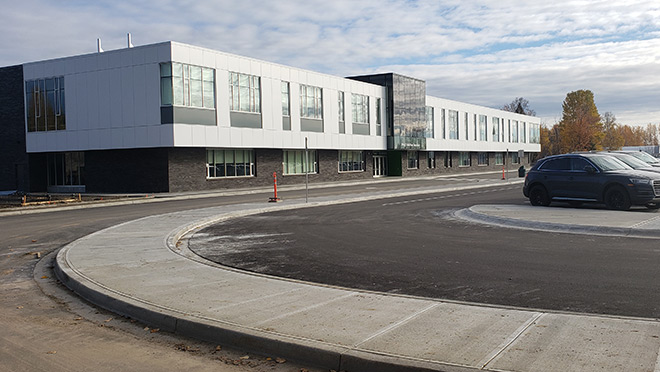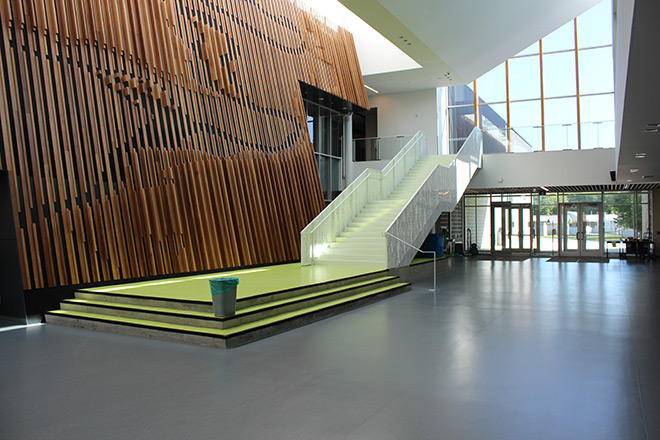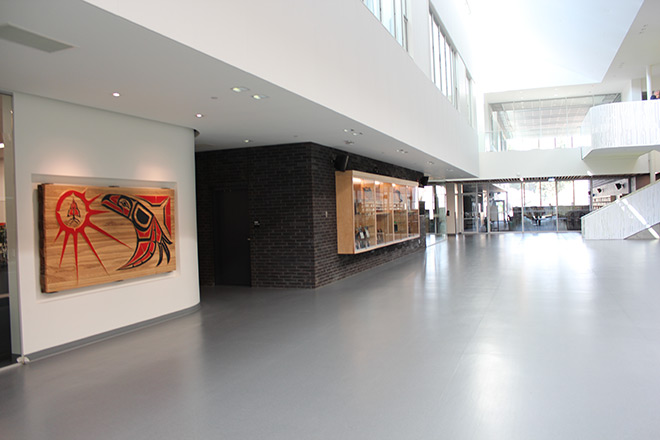Culture and energy efficiency converge at northern B.C. schools

A history of adapting technologies to the northern climate
Shas Ti Kelly Road Secondary School combines Northern B.C. culture and advanced climate control design in School District No. 57’s most ambitious energy efficiency project to date. Through a technology-driven design partnership with BC Hydro, the Prince George high school seamlessly integrated natural design elements with customized environmental control systems to help offset the effects of challenging winter weather conditions.
Sunlight and wooden features created a feeling of space and movement, while each corner of the building was planned to allow for efficiency and comfort for every season. Originally built in the 1960’s, Kelly Road Secondary school was renamed to include “Shas Ti” which means “grizzly trail” or “grizzly path” in the Dakelh dialect of the Lheidli T’enneh First Nation. Gracefully designed wooden features flow through the hallways and common areas of Shas Ti Kelly Road Secondary School – imitating the flow of water and illustrating the importance of the Nechako and Fraser Rivers to the region. This community school serves over 900 grade 8-12 students.
Barry Bepple, School District No. 57’s Energy and Sustainable Conservation Coordinator, has worked with BC Hydro on energy efficiency projects in the area for over three decades. “Everything in this project has been designed from previous learning,” he says. “Design concepts are based on experiences. Measurable results and testing during past projects have provided us with a depth of knowledge to create a winning formula for sustainable and maintainable educational buildings suited for Northern B.C. weather.”
High-efficiency heat pumps and LED lighting bring brightness and warmth
In Northern B.C., schools need to be designed to accommodate extreme winter temperatures often reaching lows of -40°C while remaining energy efficient and accommodating large seasonal variations effecting the availability of natural light.
To mitigate these extreme heating demands, Shas Ti Kelly Road Secondary School was designed to use a high efficiency HVAC system featuring a ground-source heat pump. The system was then adapted to provide each classroom with independent heating and cooling. Not only does this allow educators to adjust the temperature for day-to-day conditions, it also keeps maintenance challenges localized to one room of the building without disturbing other classrooms should they arise.
Barry explains how this necessary innovation came about: “One high school utilized heat pumps on a geo-thermal system, but then we modified the design to reduce the amount of compressor use on the Shas Ti Kelly Road installation through a four-pipe heating and cooling system with a six-way valve and a single coil in a unit ventilator for the classroom spaces. This reduced our electrical load immensely.”
Each classroom also has multi-level LED lighting that uses light sensors to tell if a room is occupied or not. It adjusts the lumen output of the lights automatically to take advantage of available external daylight - maximizing efficiency. These daylight sensor controls were chosen after exploring several options with BC Hydro, and because their components could be quickly replaced.
“We have all of this technology at other individual locations throughout our district, but this is the first opportunity we’ve had to build it and bring it all together as a collection of all the things we’ve learned,” says Barry.
Other design features include:
- Efficient boiler and low flow fixtures for domestic hot water
- High performance windows
- Increased roof and wall insulation

BC Hydro’s experts help maximize energy efficiency with each new school
“Our Commercial New Construction study provides a comprehensive modelling review of the building’s systems such as lighting, mechanical, and building envelope,” says Aron Garrecht, BC Hydro Commercial Key Account Manager for School District No. 57.
Past spot metering measurements of specific project components, such as monitoring lighting operating hours, or power/energy consumption of specific mechanical equipment helps to inform energy estimates while reviewing designs.
“When a new school is to be built, it is designed using the best possible technologies within budget. This often involves using the design of a previously built school, and then upgrading the various components of the design as budget permits. So, building envelop, seismic engineering, lighting systems, mechanical systems, electrical infrastructure, all these things are often built from a proven design,” says Aron.
“Through BC Hydro's New Construction Program, we were able to model different building attributes at the design stage with all the different systems listed for the team to determine the best course of action,” said Barry. “Funding from BC Hydro was also very important. Those dollars helped the team focus on the energy portion of the project and what that meant.”

Technology systems help reach new energy goals
By combining this range of energy conservation measures, BC Hydro estimates that Shas Ti Kelly Road will save, year after year, over 448,000 kilowatt hours of electricity.
Shas Ti Kelly Road Secondary School will meet the Leadership in Energy and Environmental Design Gold Standard, meaning that it will meet the highest international certification standards for being environmentally friendly.
Growth within BC Hydro programs motivates school districts to make positive changes
“The evolution of the Commercial Energy Managers program has helped in identifying and determining what projects to start with and how to approach their design,” says Barry. “A consistent approach to helping design, implement and subsequent follow up on the projects - with assistance on the paperwork and documentation goes a long way to a successful end.”
Always looking forward, Barry says he’ll utilize similar geo-thermal heating system in a four-pipe heating/cooling configuration again in the future. The full LED lighting with occupancy and daylight harvesting is another on his must-do list.
“We’ve demonstrated that you can save energy and provide measured savings in the maintenance of facilities while improving the learning environment for our students and staff. Doing both gives us a reason to continue,” says Barry.